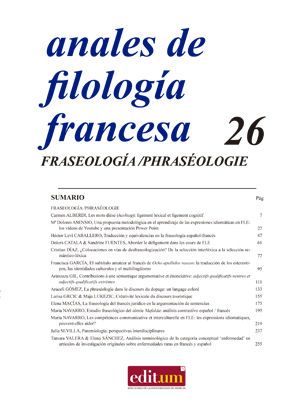The transposition of Dante and Beatrice into the underworld of the Drancy camp through the anus of Daniel Zimmermann
Abstract
The purpose of this paper is to analyze the intertextuality of Dante Alighieri’s Vita nova in Daniel Zimmermann’s L’Anus du monde. This fictional account of the Holocaust depicts François Katz, a Jewish university student who is an atheist and a deported bourgeois. As a result of his deportation experience, which we interpret as a journey of initiation, Alighieri and his work, are considered by Katz as a human and literary reference. Following this perspective, we will show the transfiguration of Dante and of Béatrice in François and Myriam, which will help explain the psychological transposition of the bourgeois courting mirrored by Zimmermann in the concentration camp environment. Furthermore, we have focused our attention on the intertextual presence of Cantique des cantiques and of Talmud. This transtextual approach will allow us to explain the stylistic choice of the novelist whose intention is to avoid any type of parodic interpretation of historical referents.
Downloads
References
Alighieri, Dante. 1826. L’Enfer (trad. de J. C. Tarver). t. II, Londres, Dulau et Co.
Alighieri, Dante. 1854-1857. La Divine Comédie. Le Paradis (trad. de M. Mesnard). t. III, Paris, Amyot.
Alighieri, Dante. 1898. Vita nova (trad. de Max Durand Fardel). Paris, Eugène Fasquelle Éditeur.
Aubry, Pierre. 1974. Trouvères et troubadours (2e édit. revue et corrigée). Genève, Slatkine Reprints.
Bakhtin, Mikhail. 1970. La Poétique de Dostoïevski. Paris, Gallimard.
Balbin, André. 1989. De Lodz à Auschwitz: en passant par la Lorraine, Nancy, Presses Universitaires de Nancy.
Bettelheim, Bruno. 1981. Survivre. Paris, Robert Laffont, coll. “Pluriel”.
Gavillet, André. 2001. “Daniel Zimmermann, un auteur du lundi”in Domaine public, nº 1469, 6 avril, 1-8.
Duits, Emmanuel-Juste, 2000. L’Autre Désir: du sadomasochisme à l’amour courtois. Paris, La Musardine, coll. “L’attrape-Corps”.
Frankl, Viktor. 1963. Man’s Search for Meaning. An introduction to logotherapy. Boston, Beacon Press books.
Gilson, Etienne. 1953. Dante et la philosophie. Paris, Librairie Philosophique J. Vrin.
Jaeck, Lucile. 2015. “De la littérature latine à la littérature française: une transition victime du cloisonnement académique” in Perspectives médiévales, no 36. < http://peme.revues.org/7852; DOI: 10.4000/peme.7852> [12/09/2018]. Date de consultation: 20 avril 2018
Levillain, Henriette. 1999. “La bérénice infidèle de Thomas Otway” in Revue de littérature comparée, no 73, 2, 53-164.
Markale, Jean. 1987. L’Amour courtois ou le couple infernal. Paris, Imago.
Panciera, Silvana. 2009. Les Béguines. Namur, Éd. du Cerf.
Bezzola, Reto Roberto. 1966. Les Origines et la formation de la littérature courtoise en occident (500-1200). t. II, Société Féodale, Paris, Honoré Champion.
Sartre, Jean-Paul. 2007. “L’amour courtois: pour une psychologie de l’homme féodal” in Les Temps modernes, no 645, 6, 76-123.
Steinberg, Maxime. 1990 Les Yeux du témoin ou le regard du borgne: l’histoire face au révisionnisme. Paris, Les Éditions du Cerf.
Zimmermann, Daniel. 1996. L’Anus du monde. Paris, Le Chercheur Midi éditeur, coll. “Roman”.
Las obras que se publican en esta revista están sujetas a los siguientes términos:
1. El Servicio de Publicaciones de la Universidad de Murcia (la editorial) conserva los derechos patrimoniales (copyright) de las obras publicadas, y favorece y permite la reutilización de las mismas bajo la licencia de uso indicada en el punto 2.
2. Las obras se publican en la edición electrónica de la revista bajo una licencia Creative Commons Reconocimiento-NoComercial-SinObraDerivada 3.0 España (texto legal). Se pueden copiar, usar, difundir, transmitir y exponer públicamente, siempre que: i) se cite la autoría y la fuente original de su publicación (revista, editorial y URL de la obra); ii) no se usen para fines comerciales; iii) se mencione la existencia y especificaciones de esta licencia de uso.
3. Condiciones de auto-archivo. Se permite y se anima a los autores a difundir electrónicamente las versiones pre-print (versión antes de ser evaluada) y/o post-print (versión evaluada y aceptada para su publicación) de sus obras antes de su publicación, ya que favorece su circulación y difusión más temprana y con ello un posible aumento en su citación y alcance entre la comunidad académica. Color RoMEO: verde.





